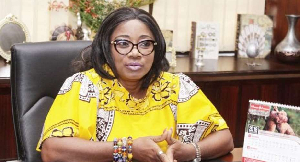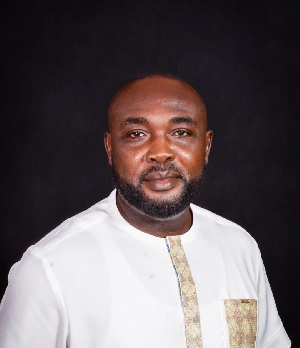Many years ago, Mr Arhin, my class 3 teacher promised to give the first three pupils who could spell all fifty words correctly in our spelling test a reward.
The entire class was excited and gingered up to learn their words. I remember how competitive the energy was. When the test day finally arrived, two of my friends and I received the best grades. Mr. Arhin fulfilled his word by giving us three mangoes each.
As students, we loved mangoes and would run across the street to get them every day after school when it was in season. We chose to share the three he handed each of us with our pals. After eating my mango, I disposed off the seed in the trash can.
However, my friend Agyepong made a little hole in the corner of the playground with his ruler and buried his seed. While we assisted him in covering the seed and watched in expectation, we had no idea what to expect.
We went to the corner of the playground after school every day to see if the seed had survived. One day, as we followed Agyepong to water it, we noticed a soft sprout with small leaves had emerge from the ground. We hurried to tell everyone in our class about it, our happiness, knowing no bounds.
Approximately eighteen years ago, during our old students’ reunion, I noticed that the mango plant in the corner of the playground had grown significantly over the years, providing shade and more of the mangoes for the present kids. Agyepong invested! He put a seed in the soil and the harvest was bountiful. Now let’s talk about investment as a young person.
What is Investment? – Investment is like planting a seed. When you invest, you put your money into something with the expectation that it will grow over time. Investing is placing your money where you hope it will eventually develop, just like a seed grows to become a tree. Purchasing and holding investment products is what it means to invest your money with the hope of seeing it increase in value. You could be able to reach your financial goals more easily if it increases your returns or gives the necessary income.
Why invest -Just as you patiently water and care for a seed to help it grow, good investments need time and attention to increase in value. Investing as a young person, helps you build wealth for the future, whether you’re planning for your education, buying a car, planning to get married or buying a house.
On rainy days, you will always have some funds to fall back on, since life is filled with lots of uncertainties. If you hide your money in your room, you will have the same amount of money or less depending on the currency and the time value of money. But investing it has a greater chance of you earning some interest on what you already have.
Different ways to invest –Investing can be done in a variety of ways, such as opening a bank account, investing in financial firms' investment products, or even investing in your own skills and education. Your alternatives for investments as a young person are not merely financial.
Acquiring a degree or certification in a desired field might improve one's knowledge and employment opportunities. These days, a first degree or some level of expertise in a selected field is necessary to land a decent job.
Many subjects are offered as courses on websites such as Coursera, Udemy, and Khan Academy, frequently for little or no cost. Participate in workshops pertaining to your professional or personal growth interests. Invest in talents that are in demand, like digital marketing, graphic design, or coding with the jobs of the future in mind.
Currently, Personal Finance Education is really important. Building a solid financial foundation requires financial literacy, which can be attained by learning about debt management, investing, saving, and budgeting. Be imaginative and creative by doing things like writing, art, or music which will help improve mental health and problem-solving abilities.
Develop your side projects skills and launch a small business, blog, or YouTube channel to explore your interests and hone your entrepreneurial abilities. It will also bring in extra income for you in the future.
Starting Small: A large sum of money is not necessary to begin investing. The accumulation of even few coins over time makes early saving crucial. Using a piggy bank or another container to hold our coins and cash is one of the simplest ways we can teach our children how to save money at an early age.
Most of us received a piggy bank at some point during our youth. Perhaps a few of us are still using our original piggy banks. It's one of the best lessons parents can impart to kids about the importance of saving money instead of squandering it.
More significantly, the piggy bank serves as a helpful reminder for people of all ages who might have forgotten the value of saving. Using piggy banks is a really easy and efficient approach to educate younger children in the family the value of saving money.
Let them pick out their own piggy bank, one they can decorate and feel proud about. They may not be saving up for anything specific when you start but encourage them to think about what they may want to buy someday. Whether it’s a new toy, a new phone, a new video game or a birthday present for their friend, it’s a good time to point out how much these items cost and how much they need to save in order to buy them.
Make the suggestion to take on some more chores to earn some extra cash. I know you're wondering what to do when the piggy bank is full. Transfer the entire amount to a Stanbic Bank Youth account and inquire about the appealing investing opportunities accessible. Invest part of your money, and you'll see it grow to achieve your own financial objectives.
Risk and Reward: Not every investment will be successful, just as not every seed will mature into a sturdy tree. While some may require patience or risk, the benefits can be substantial with careful planning. Young people can still learn to handle the risks associated with investing through education and guided experiences, even though they usually don't invest in the same way as adults do. Instructors and parents will need to guide young ones in this area.
Children will be encouraged to make decisions by parental supervision and guidance since these people offer context and insights that help them understand the effects of their actions. While doing this, we must create an atmosphere in which they can feel free to ask questions about the risks associated with their investments.
The fundamentals of investing should be taught through a deliberate effort or carefully prepared curriculum. Starting with the basics of investing, such as what it means to invest, what kinds of investments are available, and the notion of risk against reward, can help with that. While instructing kids, use of simulations is essential to their grabbing of the many ideas; get them involved in apps or games that simulate the state of the market so they may practice making choices with no actual financial risk.
To assist them grasp the process without taking on a lot of risk, they should be encouraged to start with small, manageable investments. Examples of these include a tiny portion of a family investment or a small sum in a savings account. Whether it's saving for a game, a toy, or something more, we need to help them set specific, attainable investment goals and teach them that waiting can provide better results. Teaching students about interest and fees include educating them about the costs involved in investing and describing how interest accrues on savings accounts and how fees may impact investments.
Children can learn to manage risks by being exposed to financial concepts in a positive and instructive way. The abilities and information they acquire early on with investing.
They can learn to manage risks by being exposed to financial concepts in a positive and instructive way. Early life experiences can provide a solid basis for future financial literacy and prudent investing as they become older. Similarly, we will also need to assist them in managing any rewards they receive from a certain investment.
Investing is essentially about making wise choices that will increase your financial resources over time. Future prospects and financial security can be significantly increased by getting started early and learning the foundations. As a young person, never forget that the future is just as vital as the present!
Make it a point to form an investment habit with the support and advice of the elderly in your lives. It will be worthwhile. Let this serve as a reminder to create a comfortable future for yourself and the generations who follow the next time you hear the word "investment."
Click to view details



Business News of Thursday, 31 October 2024
Source: Nana Serwaah Bossman, Contributor

















